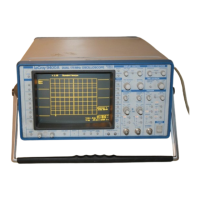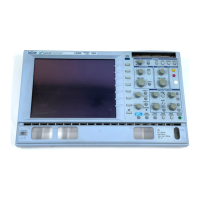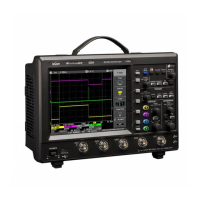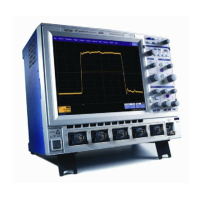D–5
Parameter Measurement
Parameter and what it does Definition Notes
ampl
Amplitude: Measures difference between
upper and lower levels in two-level
signals. Differs from pkpk in that noise,
overshoot, undershoot, and ringing do
NOT affect measurement.
top - base
(See Fig. D–1)
On signals NOT having two
major levels (such as triangle
or saw-tooth waves), returns
same value as pkpk.
area
Integral of data: Computes area of
waveform between cursors relative to
zero level. Values greater than zero
contribute positively to the area; values
less than zero negatively.
Sum from first to
last of data
multiplied by
horizontal time
between points
(See Fig. D–2)
base
Lower of two most probable states
(higher is top). Measures lower level in
two-level signals. Differs from min in that
noise, overshoot, undershoot, and ringing
do NOT affect measurement.
Value of most
probable lower
state
(See Fig. D–1)
On signals NOT having two
major levels (triangle or saw-
tooth waves, for example),
returns same value as min.
cycles
Determines number of cycles of a
periodic waveform lying between cursors.
First cycle begins at first transition after
the left cursor. Transition may be
positive- or negative-going.
Number of
cycles of
periodic
waveform
(See Fig. D–2)
cmean
Cyclic mean: Computes the average of
waveform data. Contrary to mean,
computes average over an integral
number of cycles, eliminating bias
caused by fractional intervals.
Average of data
values of an
integral number
of periods
cmedian
Cyclic median: Computes average of
base and top values over an integral
number of cycles, contrary to median,
eliminating bias caused by fractional
intervals.
Data value for
which 50 % of
values are above
and 50 % below
crms
Cyclic root mean square: Computes
square root of sum of squares of data
values divided by number of points.
Contrary to rms, calculation performed
over integral number of cycles,
eliminating bias caused by fractional
intervals.
1
2
1
N
v
i
i
N
( )
=
∑
Where:
v
i
denotes measured
sample values, and N =
number of data points within the
periods found up to maximum
of 100 periods.
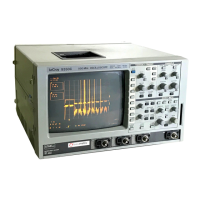
